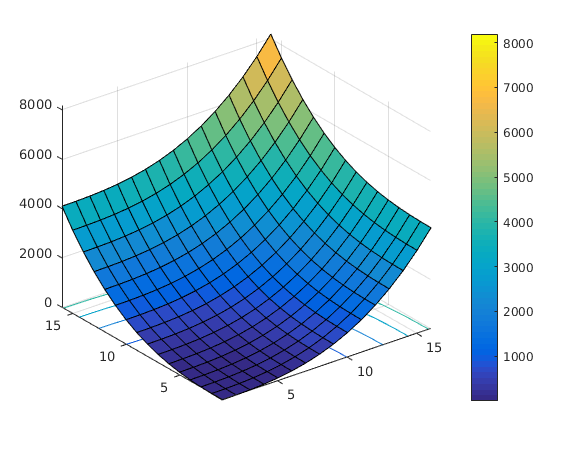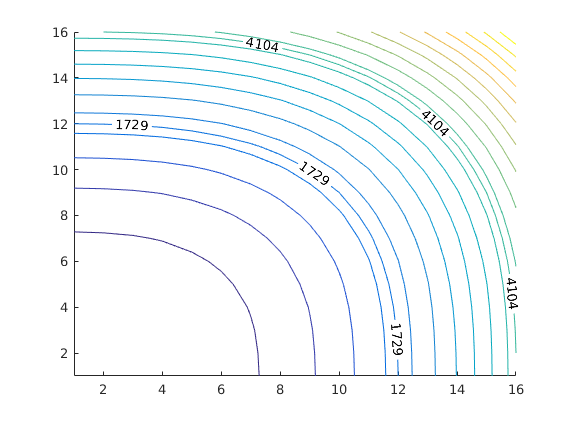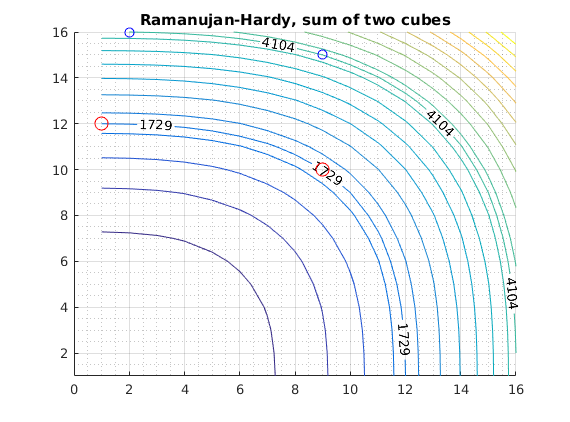Hardy's taxi number 1729 to see Ramanujan in hospital
10.8.2016 Heikki Apiola, HardyRamanujan.m
Contents
- Hardy and Ramanujan
- Form an M x M grid of pairs of numbers (in the meshgrid-way)
- Build a matrix N which counts the nr. of times each element of qubesums appears in the matrix.
- If there are 2 representations, by symmetry, there are 4 duplicates.
- Some graphics for illustration:
- Forth powers, rethinking the algorithm.
- Here's the whole code for HRTaxiNr
Hardy and Ramanujan
Here's a list of references:
- http://www.imdb.com/title/tt0787524/ The man who new infinity, Movie
- http://matematiikkalehtisolmu.fi/2008/1/ramanujan.pdf Article about Ramanujan in "Solmu", in Finnish
- G.H. Hardy: A mathematician's apology, Cambridge U.P. 1940, Finnish translation, Terra Cognita 1997.
The problem treated here is the classical one mentioned in all the above references " ...the famous taxicab incident in which Hardy says the taxi license plate has a very dull number, but Ramanujan says "it is a very interesting number"- the lowest number expressed as the sum of two cubes in two different ways ..."
Our starting point is to compute the smallest number that can be so expressed without knowing it in advance. So it is kind of converse to the incredible "sight" of Ramanujan. On the other hand we will be able to solve as many as the computing power will allow, to get more and more such numbers. Here we will just show the next such number: 4104.
Also, in the Solmu-reference above was a continuation: Hardy would have asked if Ramanujan knew the answer if cubes were replaced by power 4. Ramanujan would have thought a while and then said: "It must be a very large number". I used near to one hour CPU-time (lunch + coffee) on my laptop to show that it must be more than one million.
The first attempt works with p=3 but is too inefficient for p=4. Handling of the case p=4 forced us to design a more efficient way of handling the problem. Vectorization (elination of for-loops) and re-thinking the algorithm led us to write the function:
*H_RTaxi_Nr*, which is called at the and of this script.
Form an M x M grid of pairs of numbers (in the meshgrid-way)
. .
If you need help in meshgrid, here are two links:
https://math.aalto.fi/~apiola/matlab/opas/lyhyt/grafiikka.html#surf
close all clear M=16; i=1:M; j=1:M; [I,J]=meshgrid(i,j); % % Compute a matrix of sums of cubes for each mesh-point: % qubesums=I.^3 + J.^3;
Build a matrix N which counts the nr. of times each element of qubesums appears in the matrix.
for k=1:M for l=1:M N(k,l)=sum(sum(qubesums(k,l)==qubesums)); end end
If there are 2 representations, by symmetry, there are 4 duplicates.
[k,l]=find(N==4); values=k.^3 + l.^3 [k l values] Taxinr=min(values)
values =
1729
4104
1729
4104
1729
1729
4104
4104
ans =
12 1 1729
16 2 4104
10 9 1729
15 9 4104
9 10 1729
1 12 1729
9 15 4104
2 16 4104
Taxinr =
1729
This shows that 9^3 + 10^3 = 1729 and 12^3 + 1^3 = 1729 Also: 9^3+15^3 = 2^3 + 16 ^3 = 4104
Some graphics for illustration:
surfc(i,j,qubesums), colorbar

figure
hold on
contour(i,j,qubesums,20)
[c,h] = contour(i,j,qubesums,[1729 4104]);
clabel(c,h);

plot(9,10,'or','MarkerSize',10) plot(1,12,'or','MarkerSize',10) plot(9,15,'ob','MarkerSize',7) plot(2,16,'ob','MarkerSize',7) grid on grid minor xlim([0 M]) title('Ramanujan-Hardy, sum of two cubes')

Forth powers, rethinking the algorithm.
Better write it as a function: HRTaxiNr
help HRTaxiNr
HRTaxiNr Hardy's "uninteresting" taxinumber 1729
Ramanujan: It is the smallest numbers that can be expressed
as the sum of cubes of two numbers.
[k,l,mini]=HRtaxinr(3) returns the solution.
This can be used to solve the same prpblem with other powers as well
as long as computing resources allow.
Works instantly also if p=4, which was Hardy's next question.
Ramanujan:"It must be a very large number.
Can be genaralized to variuos directions. In addition to higher powers
there have been some investigations for more than two summands.
Exercise: Extend this to the case of 3 summands, then more ...
Published output in the Help browser
showdemo HRTaxiNr
Here's the whole code for HRTaxiNr
type HRTaxiNr
function [k,l,mindupl] = HRtaxiNr(p,M)
% HRTaxiNr Hardy's "uninteresting" taxinumber 1729
% Ramanujan: It is the smallest numbers that can be expressed
% as the sum of cubes of two numbers.
% [k,l,mini]=HRtaxinr(3) returns the solution.
% This can be used to solve the same prpblem with other powers as well
% as long as computing resources allow.
% Works instantly also if p=4, which was Hardy's next question.
% Ramanujan:"It must be a very large number.
% Can be genaralized to variuos directions. In addition to higher powers
% there have been some investigations for more than two summands.
% Exercise: Extend this to the case of 3 summands, then more ...
if nargin==1
switch p
case 2
M=9;
case 3
M=16;
case 4
M=200;
otherwise
warning(['No default M-value for p = ' num2str(p)])
end
end
i=1:M;
j=1:M;
[I,J]=meshgrid(i,j);
%
% Compute a matrix of sums of power p for each mesh-point:
%
powersums=I.^p + J.^p;
%% Remove upper diagonal to avoid "symmetry-matches"
%
pickLD=logical(tril(ones(M))); % Lower diagonal logical matrix.
powV=powersums(:); % powersums-matrix columwise into long vector. %
powLD=powV(pickLD(:)); % Pick lower diagonal entries.
%
sortedS=sort(powLD);
differences=diff(sortedS);
% Note that difference-vector has 0, at first member of duplicate.
pick=differences==0;
duplicates=sortedS(pick(1:end-1));
%%
mindupl=min(duplicates);
[k,l]=find(mindupl==powersums);
end
Looking at the code, in finding the number of occurrencies, I wrote a worksheet of various approaches:
[k,l,mindu]=HRTaxiNr(2) % Sum of squares
k =
7
5
1
l =
1
5
7
mindu =
50
[k,l,mindu]=HRTaxiNr(3) % Sum of qubes
k =
12
10
9
1
l =
1
9
10
12
mindu =
1729
Here's the taxi number
[k,l,mindu]=HRTaxiNr(4) % Sum of fourth powers % % So we have the answer (635318657) to Hardy's question, where Ramanujan could say: % 'It must be a very large number'
k =
158
134
133
59
l =
59
133
134
158
mindu =
635318657